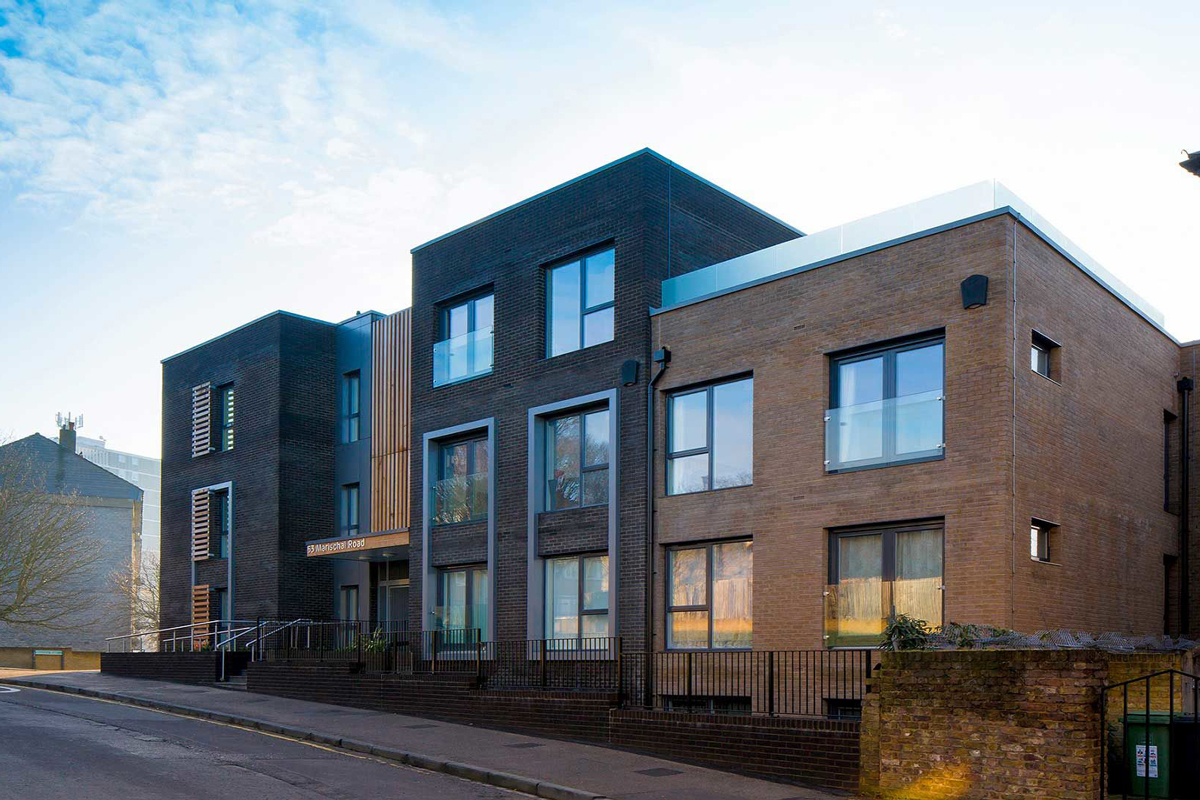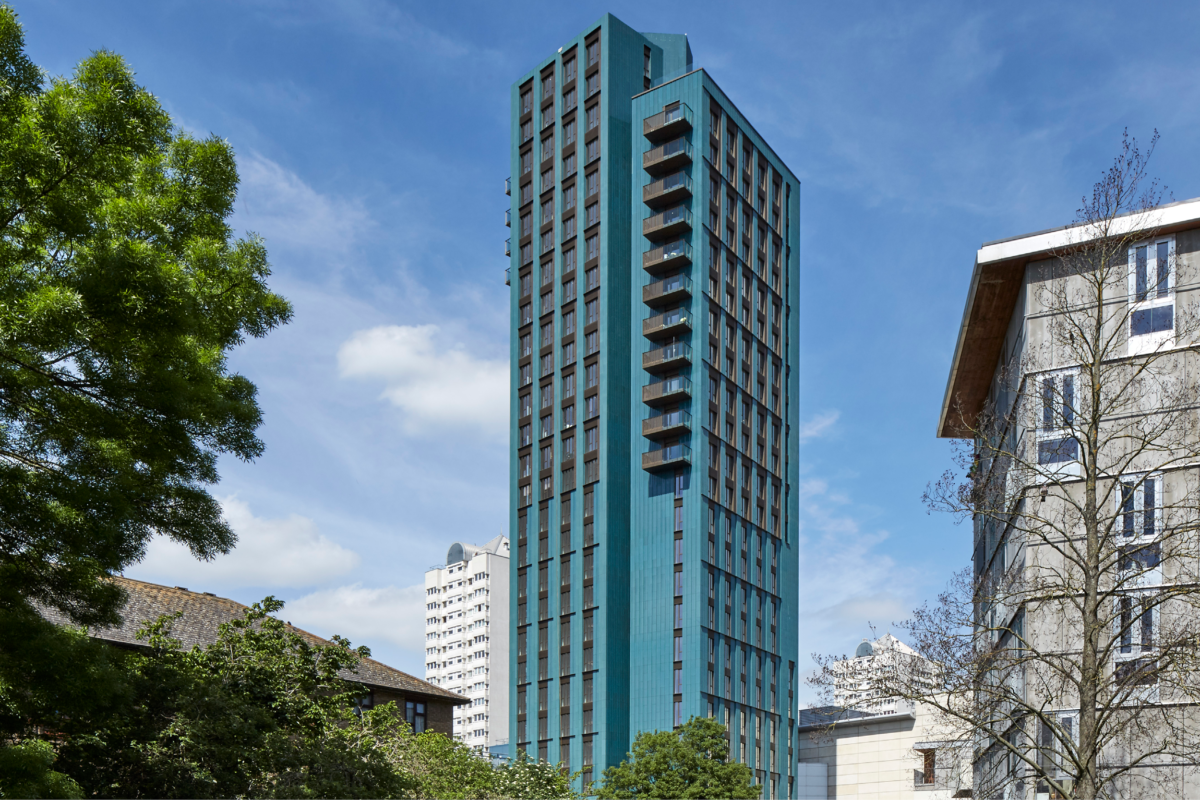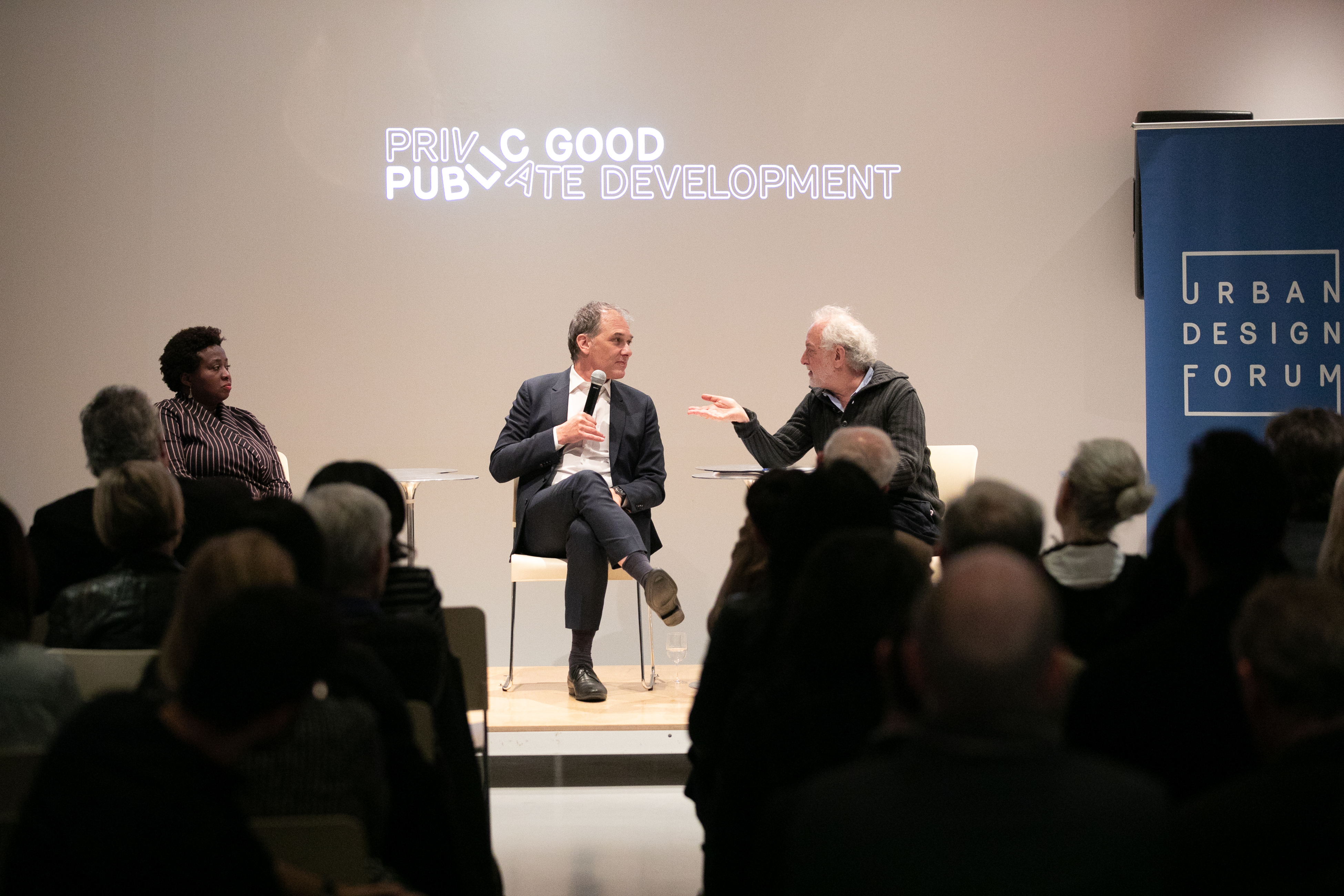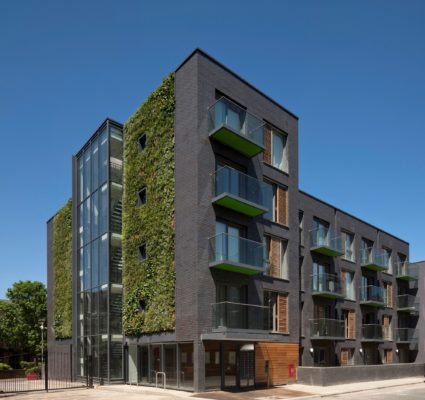
The Urban Design Forum hosted its fourth Global Exchange: Private Development, Public Good event with affordable housing developer Marc Vlessing. As chief executive officer for Pocket Living, Marc develops new compact homes sold directly to middle-earning first-time buyers. Buyers are not permitted to rent their properties, and are required to sell to other middle-income Londoners. While compact units have stirred much debate, the Mayor of London endorsed Pocket Living last year with a £25m investment to develop over 1,000 new homes by 2021. Before the off-the-record event, Urban Design Forum Executive Director Daniel McPhee sat down with Marc to learn more about Marc’s perspective and the nuances of the Pocket Living model.
Daniel McPhee: I’m curious to hear a little more about how you got into the housing space yourself. I know you started your career in finance, and then as chief executive of a theater and cinema group.
Marc Vlessing: The thing that really brought it together was a conversation that I’d had a couple of years ago with one of the projectionists in our cinemas. He said “you know what you have to understand: I do this because I love the cinema; my father loved the cinema. But my son of 12—sitting at home playing on his Nintendo—he’s never going to commute the 1 ½ hours it takes me to get to work. He’s never going to be able to afford to live close to work”.
And so, I started to ask myself the question: how are we going to keep these cinemas and theaters alive with people on very modest salaries? And that was the moment when the light went off—if I could set up a housing company that purposely tried to find a way to deliver housing for people on modest salaries in London, that would bring everything that I had done in my career together.
DM: One of the most notable things about your housing model is how you’re taking a different approach by building specifically for young first-time buyers, rather than mixing affordable units into all new housing. Why focus on this group of people?
MV: What’s really fascinating about them as a cohort is that they have been under-researched and under-served by policy makers. A heck of a lot of effort goes into open market housing. I mean, the banks have to research the market because they’ve got so much of their balance sheets tied up in it. And then, a heck of a lot of academic researchers look at social housing. But middle-market housing—”intermediate” housing, “key worker” housing, “workforce” housing—tends to be really under-researched. To me Pocket was a market opportunity. It was a policy opportunity.
Apparently one of the greatest Canadian ice hockey trainers once said that the best ice hockey player ever was not the guy who went to the puck, but it was the guy who went to where the puck was going to be. And I think what we did with Pocket was ask where the puck was going to be. We were asking ourselves this question 10 years before the politicians woke up to it, and by the time they woke up to it we were already there starting to build this housing.

Pocket tower at Mapleton Crescent in Wandsworth
DM: But why target singles and couples in particular? How are you using design as a way to build for those people?
MV: The formula that we came up was a compact one of 400 square foot flats—they are not micro! Clearly if you want to make something more affordable, then making it more compact is one way to go. But our units also had to meet stringent design criteria that we set for the product in terms of economics and functionality: oversized fenestration to maximize daylight; complex wiring diagrams to maximize night lighting; continuous flooring; a living room big enough for a four-seater IKEA sofa; a bedroom big enough for a king-sized bed, plus side tables and a built-in wardrobe.
We came up with this one-bedroom model because a building with a mix of two, three, or four-bedroom flats returns a much lower margin than on one-bedroom flats. The best sites for us are the cheapest land we can buy in the most expensive boroughs—sites that tend to be next to public housing. Then, we are able to price these units through a formula to a deep discount to the market. Our discount is typically 20% to market, and of course the planning policy people in London think “Oh, well that’s great, but how do you protect that?”
DM: Right, I was going to ask, how are you preserving the affordability after the first buyer decides to sell?
MV: We actually imposed on ourselves the care of being the regulator of the product. We set up a team which certifies resales. When you buy a Pocket flat, your lease states that you are not allowed to sell your flat without us certifying that the person you are selling is eligible.
The eligibility criteria are that you earn less than a certain amount of income, and that you live and work in the Borough. The household income per year is set by the Mayor of London through his economics unit in something called the “London Plan”, which is the spatial development strategy of London. This was a great hook of which to peg this housing. But we use it as a market mechanism—nobody had really thought about doing that. We created a housing formula without subsidy. There’s nothing financially driven—there’s not financial subsidies, or a grant, or a bequest, or a gift from the state. It’s all about planning density, and then self-regulation.
DM: One thing that’s notable about new development in New York is the kind-of surge of amenities: we have flower-arranging workshops, pet spas….
MV: It’s a nuclear arms race!
DM: Exactly. So, could you talk a little bit about how you’re using design in the broader building – not just the unit?
MV: To my mind, the kind of people that we build for are so pleased that we built something that’s fit for purpose, as close to the center of town as we can make it, at a cost that is cheaper than renting….they don’t want a car parking space! They haven’t got money for a car parking space. They certainly don’t have money for gyms, and dog compounds. So, the issue doesn’t really arise.
It is is a real problem that there has been this amenity warfare among developers in a place like New York because it is really, really hard to come off that stuff. It becomes so out of reach for the average person. I think New York is absolutely right to rethink what a utilitarian approach to housing for singles and couples could be.
We’re in the mess that we are with the housing market because we’ve been giving no thought to singles and couples—young professionals—over the last 15, 20, 25 years.
The interesting thing about this is that politically you go to Mayors on the Left and on the Right and you talk about singles and couples, and you can immediately see their political filtering mechanisms, which go: “Yeah, but they don’t really matter do they, because what I really should be doing is public housing for families.” While there is always a need for more public housing for families –I’m very supportive of public housing for families—the truth of the matter is that we’re in the mess that we are with the housing market because we’ve been giving no thought to singles and couples—young professionals—over the last 15, 20, 25 years. They are economically so important. Secondly, they can vote with their feet—they can move away from these places if they become completely unaffordable. They are not hugely demanding. They work so much they don’t have time to be political about housing.
I think one of the reasons we are in the situation we are in is that the people who complain about housing problems tend to be families. There is a political imperative here for the 30-somethings to make their voices much more heard because ultimately that’s what drives the game.

Marc in conversation with Michael Sorkin and Beatrice Sibblies at the New Museum
DM: Now, reflecting on the families a little bit, do you see Pocket units as starter homes for people thinking about starting a family in a couple years? Or, are you trying to read demographics and say that there are a lot of singles in cities?
MV: If I’m honest, I’ve changed my view about this. I thought what I was doing is creating a staging post. What I now realize that we’re doing is creating a new format, a lifestyle, for people who are almost certainly going to be staying in those homes a lot longer than we ever thought they would. Which is why I’m so pleased that we never went for micro. You can stay in a Pocket flat for a long time, and people do.
What I think is happening—and this is not caught by the statistical data tracking of governments yet—is that there is a much, much larger group of people now who are going to be single or couple-based because they are not getting married, they are not having children, they are living longer, and they are divorcing rather often. We reckon that of the new household growth in the UK, 60-70% is going to be singles and couples. If that is right, then this is a demographic shift that we haven’t anticipated at all within cities. Then, Pocket is not a staging post towards family life, but it is a form of housing that is going to have to be expanded dramatically.
DM: You also focus on community preference–a term we use in New York. You’re looking for buyers who already live in a neighborhood. Could you talk a bit more about tenant selection, and the kinds of people that are now living in Pocket?
MV: From initial planning onwards, we commit that we will only sell to people who either live or work in the borough–we have 33 boroughs in London–on a household income level that falls below the affordability threshold set by the Mayor of London. Our selection process is enshrined within the planning system.
What’s interesting about our buyers as a group is that the average age is 32, the average income is £42,000, and they have on average been renting for eight years. 85-90% are single. 10% are couples. And what’s really fascinating is that there is a skew amongst the singles in favor of single women. We reckon about 65% are single women. We’re trying to dig into the data to try to understand what’s behind that skew.

Pocket development at Fermoy Road in Westminster
DM: It would be helpful to talk about politics and how you’ve been able to get this done. I think your model is a little unusual and flies very much in the face of what New York City is trying to do, which is mix these mandatory affordable rentals in new developments—something London is doing as well. So, how are you able to make the case–whether to the planning authority, or council members–that this is the right model to pursue?
MV: I learned fairly early on that the politics of housing does not break down on party lines. It breaks down on age brackets. So, if you have group of councilors or politicians over the age of 50, who have lots of money tied up in their own housing entity, they find it quite difficult to understand Pocket. When you have politicians in their 30s who might not have been able to get a decent flat to rent or to buy, then you’re having a different conversation.
If you want to disrupt something so slow, conservative and stodgy as planning policy and housing markets, then you need to focus your activities where you are going to be able to shift the dial–so go for younger politicians. The best of the politicians are proud of it because they feel they can say to their electors that they are doing something.
D: And do you find that the politicians are good partners in cutting some of the tensions that new development often engenders in neighborhoods?
MV: I think there are a lot of brave politicians, who go into politics for the right reason who know that the average NIMBY is not going to be a friend of any development process. The politicians that we work with stand proud and shoulder-to-shoulder in the process.
The only two kind of people who can afford to live are either people on £150,000+ a year, or people who are on public benefit—what kind of community is that?
We’re now getting to the point in parts of London where the only two kind of people who can afford to live are either people on £150,000+ a year, or people who are on public benefit—what kind of community is that? And that’s happening in New York as well. A community hollows out once you lose these middle classes. You’re left with very dysfunctional area. It drains the life out of the city.
There is a limit to which you can force people to commute unacceptable distances. There is a limit to how much you can ring-fence particular priority groups. And there’s a point at which you just have to become rational—these are economically, socially, culturally, politically important places. And you have to give them the oxygen that they deserve to succeed.
DM: It sounds like you’ve been recognized by some high-profile attention from the Mayor. I’m curious to know how that’s changed the way that you are thinking about the future of Pocket and where you can be making a difference.

Green glazed-terracotta tile facade of Mapleton Crescent
Yes, we are a market facing blue-blooded capitalist organization at one level–we are for-profit–but we could not exist without the regulatory cloak of the public sector to whom we owe everything. This two-way process of innovating—it’s on both sides. The public sector has had to innovate as much as we have to made it work. It’s very symbiotic. And although it sounds very pat, it crucially does rely upon trust. To be able to look your politicians and policy-makers in the eye and convince them that what you say you’re are going to do, you’re really going to do.
DM: As you’re thinking about coming stateside, what will have to change?
MV: Well, this sounds very arrogant, but we have unlimited growth opportunities in our own market. If a politician or a Mayor wants us, they’re going to have to, not woo us—you know we’re an easy date, we’ll come—but they are going to have to give us something to get us into it. A nice big juicy piece of public land wouldn’t be a bad thing. A lot of our properties are on public land. A housing strategy director who is prepared to stretch the rules and play with us in order to make things possible rather than telling us why it’s all impossible. A framework of understanding in which we all recognize that we’re going to do one of these developments to see how it works, that can kick the tires off, and then we’ll do many more. That’s the city I would love to work with in America.
For more information about Pocket Living, please visit their site.
Image Credits: (1) Pocket Living London, Marischal Road SE13 (2) Pocket Living London, Mapleton Crescent SW18 (3) Urban Design Forum/Samuel Lahoz (4) Pocket Living London, Fermoy Road W9 (5) Urban Design Forum/ Samuel Lahoz (6) Pocket Living London, Mapleton Crescent SW18.